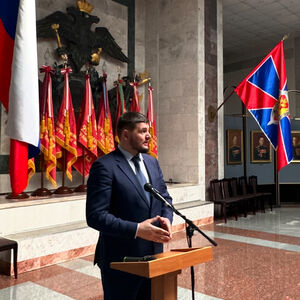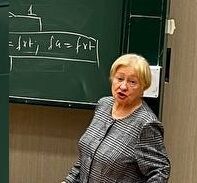Диссертация (1174267), страница 19
Текст из файла (страница 19)
7. – P. 2032-2060.13.Marmarou,A.IMPACT database of traumaticbraininjury: design and description / A. Marmarou, J.Lu, I.Butcher et. all. // J. Neurotrauma. –2007. – Vol. 24. - №. 2. – P. 239-50.14.injury:Jeremitsky, E. Harbingers of poor outcome the day after severe brainhypothermia,hypoxia,andhypoperfusion/E.Jeremitsky,L.Omert,C.M.Dunham et al. // J.
Trauma. – 2003. – Vol. 54. – P. 312–319.15.Liu, S. Posttraumatic cerebral infarction in severe traumatic brain injury:characteristics, risk factors and potential mechanisms / S.Liu, X.Wan, S.Wang et al. //Acta. Neurochir. – 2015. – Vol. 157. – №. 10. – P. 1697-1704.16.Manley, G. Hypotension, hypoxia, and head injury: frequency, duration,and consequences / G.Manley, M.M.Knudson, D.Morabito et al.
//Arch. Surg. -2001. –Vol. 136. – P. 1118 –1123.17.Chi, J.H. Prehospital hypoxia affects outcome in patients with traumaticbrain injury: a prospective multicenter study / J.H.Chi, M.M.Knudson, M.J.Vassar et al.// J. Trauma. – 2006. – Vol. 61. - №. 5. – P. 1134-41.11318.Broughton, B.R. Apoptotic mechanisms after cerebral ischemia /B.R.Broughton, D.C.Reutens, C.G.Sobey. // Stroke. – 2009. – Vol. 40. – P.
331–339.19.Fann, D.Y. Intermittent fasting attenuates inflammasome activity inischemic stroke / D.Y.Fann, T.Santro, S.Manzanero et al. // Exp. Neurol. – 2014. – Vol.257. – P. 114–119.20.Studer,L.Enhancedproliferation,survival,anddopaminergicdifferentiation of CNS precursors in lowered oxygen / L.Studer, M.Csete, S.H.Lee et al.// J. Neurosci. – 2000.
– Vol. 20. – P. 7377–7383.21.Ara, J. Hypoxic-preconditioning enhances the regenerative capacity ofneural stem/progenitors in subventricular zone of newborn piglet brain / J.Ara, S.DeMontpellier. // Stem. Cell. Res. – 2013. – Vol. 11. – P. - 669–686.22.Tsai, Y.W. Post ischemia intermittent hypoxia induces hippocampalneurogenesis and synaptic alterations and alleviates long-term memory impairment /Y.W.Tsai, Y.R.Yang, S.H.Sun et al. // J.
Cereb. Blood Flow Metab. – 2013. – Vol. 33. –P. 764–773.23.Zhang, K. Notch1 mediates postnatal neurogenesis in hippocampusenhanced by intermittent hypoxia / K.Zhang, T.Zhao, X.Huang et al. // Neurobiol. Dis.– 2014. – Vol. 64. – P. 66–78.24.Hubert, A. Casein kinase 2 inhibition decreases hypoxia-inducible factor-1activity under hypoxia through elevated p53 protein level / A.Hubert, S.Paris, J.P.Piretet al. // J.
Cell Sci. – 2006. – Vol. 119. – P. 3351–3362.25.Sano, M. p53-induced inhibition of Hif-1 causes cardiac dysfunction duringpressure overload / M.Sano, T.Minamino, H.Toko et al. // Nature. – 2007. – Vol. 446. –P. 444–448.26.Balagurumoorthy, P. Four p53 DNA-binding domain peptides bind naturalp53-response elements and bend the DNA / P.Balagurumoorthy, H.Sakamoto,M.S.Lewis et al. // Proc. Natl. Acad. Sci. – 1995.
– Vol. 92. – P. 8591–8595.27.MacGregor, D.G. Brain edema induced by in vitro ischemia: causal factorsand neuroprotection / D.G.MacGregor, M.V.Avshalumov, M.E.Rice. // J. Neurochem. –2003. – Vol. 85. - №. 6. – P. 1402-11.11428.Heiss, W.D. The ischemic penumbra: how does tissue injury evolve? /W.D.Heiss, N.Y.Ann. // Acad Sci. – 2012.
– Vol. 1268. – P. 26-34.29.Lovelock, C.E. Time trends in outcome of subarachnoid hemorrhage:Population-based study and systematic review / C.E.Lovelock, G.J.E.Rinkel,P.M.Rothwell. // Neurology. - 2010. – Vol. 74. – 3. 19. – P. 1494-1501.30.Ingall, T. A multinational comparison of subarachnoid hemorrhageepidemiology in the WHO MONICA stroke study / T.Ingall, K.Asplund, M.Mahonen etal. // Stroke. – 2000. – Vol. 31.
– P. 1054-1061.31.Kreiter, K.T. Predictors of cognitive dysfunction after subarachnoidhemorrhage / K.T.Kreiter, D.Copeland, G.L.Bernardini et al. // Stroke. – 2002. – Vol.33. – №. 1. – P. 200-208.32.Frazer, D. Coiling versus clipping for the treatment of aneurismalsubarachnoid hemorrhage: a longitudinal investigation into cognitive outcome /D.Frazer, A.Ahuja, L.Watkins et al. // Neurosurgery. – 2007. – Vol.
60. - №. 3. – P.434-441.33.Doerfler, S. The Incidence And Impact Of Secondary Cerebral Insults OnOutcome Following Aneurysmal Subarachnoid Hemorrhage / S.Doerfler, J.Faerber,G.M.McKhann et al. // World Neurosurgery. – 2018. – Vol. 114. – P. 483-494.34.Hassid, V.J. Definitive establishment of airway control is critical foroptimal outcome in lower cervical spinal cord injury / V.J.Hassid, M.A.Schinco,J.J.Tepas et al. // J.
Trauma. – 2008. – Vol. 65. - №. 6. – P. 1328–1332.35.Aarabi, B. Predictors of pulmonary complications in blunt traumatic spinalcord injury /B.Aarabi, J.S.Harrop, C.H.Tator et al. // J. Neurosurg. Spine. – 2012. – Vol.17. - №. 1. – P. 38–45.36.Como, J.J. Characterizing the need for mechanical ventilation followingcervical spinal cord injury with neurologic deficit / J.J.Como, E.R.Sutton, M.McCunnet al.
// J. Trauma. – 2005. – Vol. 59. - №. 4. – P. 912–916.37.Velmahos, G.C. Intubation after cervical spinal cord injury: to be doneselectively or routinely? / G.C.Velmahos, K.Toutouzas, L.Chan et al. // Am. Surg. 2003. – Vol. 69. - №. 10. – P. 891–894.11538.Craven, D.E. Epidemiology of ventilator-associated pneumonia /D.E.Craven. // Chest. – 2000.
– Vol. 117. - №. 4. Suppl. 2. – P. 186–187.39.Page, V. Delirium in Critical Care: Core Critical Care / V.Page, E.W.Ely.Cambridge: Cambridge University Press, 2011.40.Pisani, M.A. Cognitive impairment in the intensive care unit / M.A.Pisani,L.McNicoll, S.K.Inouye // Clin. Chest. Med.
– 2003. – Vol. 24. – P. 727—737.41.Van Gool, W. A. Systemic infection and delirium: when cytokines andacetylcholine collide / W.A.Van Gool, D. Van de Beek, P.Eikelenboom // Lancet. 2010. – Vol. 375 (9716). – P. 773—775.42.Beloosesky, Y. Different C-reactive protein kinetics in postoperative hip-fractured geriatric patients with and without complications / Y.Beloosesky, J.Grinblat,A.Pirotsky et al.
// Gerontology. – 2004. – Vol. 50. – P. 216—222.43.Flacker, J.M. Endogenous anticholinergic substances may exist duringacute illness in elderly medical patients / J.M.Flacker, J.Y.Wei // J. Gerontol. A: Biol.Sci. Med. Sci. – 2001. – Vol.
56. – P. 353-355.44.Stefano, G.B. The immune-neurolink and the macrophage: postcardiotomydelirium, HIV-associated dementia and psychiatry / G.B.Stefano, T.V.Bilfinger,G.L.Fricchione // Prog. Neurobiol. – 1994. – Vol. – 42. – P. 475—488.45.Bonds, B.W. Predicting secondary insults after severe traumatic braininjury / B.W.Bonds, S.Yang, P.F.Hu et al. // J. Trauma Acute Care Surg.
– 2015. – Vol.79. - №. 1. – P. 85-90.46.Brugniaux, J.V. Highs and lows of hyperoxia: physiological, performance,and clinical aspects / J.V.Brugniaux, G.B.Coombs, O.F.Barak et al. // Am. J. Physiol.Regul. Integr. Comp. Physiol. – 2018. Vol. – 315. - №. 1. – P. 1-27.47.Taher, A. Effects of Normobaric Hyperoxia in Traumatic Brain Injury: ARandomized Controlled Clinical Trial / A.Taher, Z.Pilehvari, J.Poorolajal et al. //Trauma Mon. – 2016.
– Vol. 21. - №. 1. – P. 26772.48.Zauner, A. Brain oxygenation and energy metabolism: part I. Biologicalfunction and pathophysiology / A.Zauner, W.P.Daugherty, R.M.Bullock et al.Neurosurgery. – 2002. – Vol. 51. – P. 289–302.//11649.Siggarard-Andersen, O. Oxygen status of arterial and mixed venous blood./ O.Siggarard-Andersen, I.H.Gothgen, N.Fogh-Andersen et al. // Crit.
Care. Med. 1995. – Vol. 23. – P. 1284–1293.50.Martini, R.P. Targeting brain tissue oxygenation in traumatic brain injury /R.P.Martini, S.Deem, M.M.Treggiari // Respir. Care. – 2013. – Vol. 58. – P. 162–169.51.Stochetti, N. Traumatic intracranial hypertension / N.Stochetti, A.I.R.Maas.// N. Engl. J. Med. – 2014. – Vol. 370.
– P. 2121–2130.52.Perez-Barcena, J. Intracranial pressure monitoring and management ofintracranial hypertension / J.Perez-Barcena, J.A.Lompart-Pou, K.H.O’Phelan // Crit.Care. Clin. – 2014. – Vol. 30. – P. 735–50.53.Menon, D.K. Diffusion limited oxygen delivery following head injury /D.K.Menon, J.P.Coles, A.K.Gupta et al // Crit. Care. Med.
– 2004. – Vol. 32. – P.1384–1390.54.Veenith, T.V. Pathophysiologic mechanisms of cerebral ischemia anddiffusion hypoxia in traumatic brain injury / T.V.Veenith, E.L.Carter, T.Geeraerts et al// JAMA Neurol. – 2016. – Vol. 73. – P. 542–550.55.Lelubre, C. Anemia management after acute brain injury / C.Lelubre,P.Bouzat, I.A.Crippa et al // Crit. Care. – 2016. – Vol.
20. - P. 152.56.Lelubre, C. Transfusion strategies in patients with traumatic brain injury:which is the optimal hemoglobin target? / C.Lelubre, F.Taccone. // Minerva Anestesiol.– 2016. – Vol. 82. - №. 1. – P. 112–116.57.LeRoux, P. Haemoglobin management in acute brain injury / P.LeRoux. //Curr. Opin. Crit. Care. – 2013. – Vol. 19. – P. 83–91.58.Oddo, M. Anemia and brain oxygen after severe traumatic brain injury /M.Oddo, J.Levine, P.Le Roux et al // Intensive Care Med. – 2012. – Vol. 38.
















